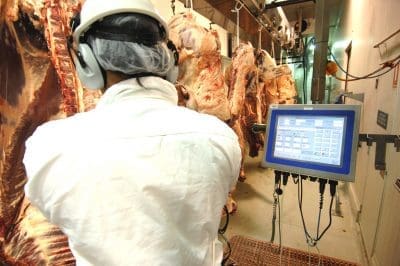THE final quarter of 2024 is shaping as one of the highest beef production quarters on record, with the processing sector finding a ‘fifth gear’ since mid-October.
Seven of the eight busiest processing weeks of the year have been seen since the week ending 18 October, pushing annual beef exports to an inevitable record by the time processors close their doors in two weeks’ time.
 As this earlier report shows, beef exports for 2024 should close at somewhere near 1.29 million tonnes, surpassing the previous record of 1.23 million set in 2016.
As this earlier report shows, beef exports for 2024 should close at somewhere near 1.29 million tonnes, surpassing the previous record of 1.23 million set in 2016.
The past eight weeks’ national kill reported by NLRS has averaged almost 143,900 head, up about 6000 a week on the previous two-month average.
Processors across the eastern states have gradually added additional working staff as the year has progressed, steadily easing the labour blockage and promoting the gradual rise in slaughter numbers that has occurred during the later stages of the year.
Last week, ended 6 December, produced an output of 143,835 adult cattle, up about 20,000 head on the same time last year.
Cattle buyers’ cue goes in the rack
Most large export processors have put the cue in the rack for direct consignment cattle bookings for 2024, with most kill slots now covered for the remaining two weeks of the season.
Full 2024 plant closure dates and 2025 re-openings are included in this report published yesterday.
Hot weather is challenging slaughter cattle delivery logistics in some areas this week, but not enough to disrupt supply, one contact said this morning.
Several large multi-site, multi-state processors are now offering space bookings for January kills in Queensland, with one of those prepared to offer a price, for week-one kills only – the same money as in this year’s final grids published below.
Some of this strategy may be to buy some ‘insurance’, as several Queensland processors are returning to work a week earlier than normal, and may be worried about potential weather disruptions to supply during the first week back at work.
Some Queensland processors continue to supplement late-season kills with a few saleyard cattle this week – in one case operating as far south as Wodonga, Victoria this morning, to take advantage of current north-south price differentials. That trend started about three weeks ago, reversing the cycle seen during much of 2024 when southern processor buyers were a familiar sight in Queensland saleyards for much of the year.
All active Queensland grids remained unchanged this week, and now look unlikely to move before the lights are turned off for 2024.
For delivery in the state’s southern region in the next two weeks, grids are showing 560c/kg on heavy cows and 620-630c on four tooth heavy grass ox, with implant. Processors in Central Queensland are typically 10c behind those rates, but some CQ plants are now either closed for the 2024 season, or about to finish on Friday.
In southern states, most offers are steady this week, after some dropped 10c/kg a week or two ago. Operators in eastern parts of South Australia are offering 540c/kg on good cows this morning, and 610c on four-tooth grass ox. Southern NSW rates are mostly unchanged this week, with some grids showing 510c/kg on heavy cows and 590c/kg on grass ox, reflecting the recent lift in supply.
On the domestic market, beef demand tends to fall in a hole from mid December to early January, as consumers focus on turkey, ham and yuletide festive foods, reducing demand for domestic-weight MSA-type yearling cattle for a period. That’s slowed demand for good MSA type steer and heifer.
Saleyards near season end
With the second-last sales of the year occurring this week in many selling centres, auction prices continue to rise for young cattle, with processor types mostly firm to dearer.
Gunnedah sale this morning yarded 2920 head, up 15pc on last week. That increase was mostly made up of feeder cattle. Young cattle made up by far the largest percentage of the offering with the majority in the medium and heavyweight classes. There were limited supplies of well finished export steers and heifers while there was a fair supply of cows. Well finished heavy grown steers to process experienced little change while the well finished heavy heifers were keenly sought, with the best of them as much as 20c/kg dearer. There was also strong processor demand in the cow market with market trends showing significant improvement.
Wodonga sale this morning yarded 2200, up 670 or 30pc on last week, due to recent market rises. All buyers were present at the sale, including a notable Queensland processor, which contributed to the stronger competition. The market for heavy steers and bullocks remained robust, with good numbers available and plenty of finish evident. Heavy steers and bullocks gained 9-17c, with crossbred bullocks showing the most significant improvements. Prices ranged from 305-377c/kg. The cow market also displayed strength, with heavy cows increasing by 8-15c as the sale progressed, to average 301c/kg. The middle run of leaner types improved by 11c, selling from 248-284c/kg.
A preliminary Roma store sale report said there was a yarding of 5317 head this morning – up almost 2000 head on last week. Yearling steers 400-480kg topped 406c/kg, while grown steers 500-600kg made to 316c/kg to processors. Grown steers over 600kg topped 339c/kg. Full report tomorrow.
